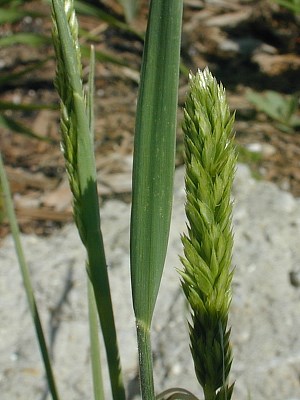Description: This native perennial grass forms a
tight tuft of culms and leaves about ½–1½' tall. The culms
are light green, terete, and glabrous to finely pubescent. The alternate leaves
are located mostly along the lower half of each culm. The leaf blades are up to
1/8" across (3 mm.) and 6" long; they are medium green to greyish blue, flat to
somewhat involute (rolled inward), and slightly pubescent to hairless. The leaf
sheaths are similar in color to the leaf blades and usually pubescent. There
are remnants of dried leaves surrounding the base of each tufted plant; these
dried leaves are light grey or straw-colored. Each culm terminates in a
spike-like panicle of florets about 3-6" long. This panicle is initially light
to medium green, but it later becomes light tan to brown. The branches of this panicle
are up to 1" long and appressed to ascending; they subdivide into branchlets
with terminal spikelets. Each spikelet is 5-6 mm. long and flattened; it
consists of a pair of glumes at the bottom and 1 or 2 pairs of lemmas. Each
lemma has a palea that encloses a single perfect floret. The glumes and lemmas
are ovate-lanceolate, keeled, and hairless. The lemmas and larger glume are 4-5
mm. long, while the smaller glume is 3-4 mm. long. The blooming period occurs
during the late spring or early summer (hence the common name of the species).
The florets are wind-pollinated. After the grains ripen, disarticulation is
above the glumes. The root system is fibrous. June Grass normally occurs in
scattered clumps.
tan to brown. The branches of this panicle
are up to 1" long and appressed to ascending; they subdivide into branchlets
with terminal spikelets. Each spikelet is 5-6 mm. long and flattened; it
consists of a pair of glumes at the bottom and 1 or 2 pairs of lemmas. Each
lemma has a palea that encloses a single perfect floret. The glumes and lemmas
are ovate-lanceolate, keeled, and hairless. The lemmas and larger glume are 4-5
mm. long, while the smaller glume is 3-4 mm. long. The blooming period occurs
during the late spring or early summer (hence the common name of the species).
The florets are wind-pollinated. After the grains ripen, disarticulation is
above the glumes. The root system is fibrous. June Grass normally occurs in
scattered clumps.